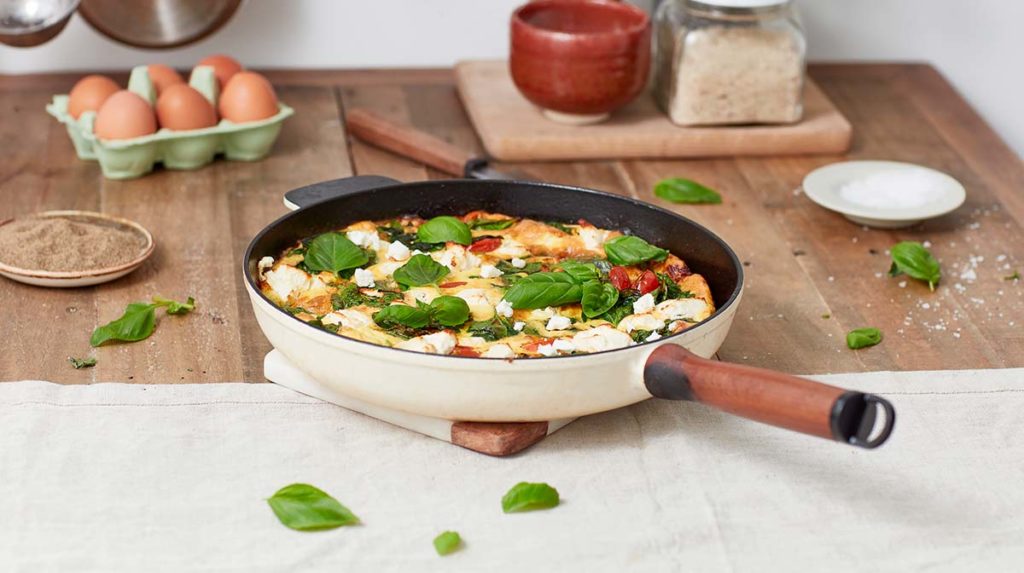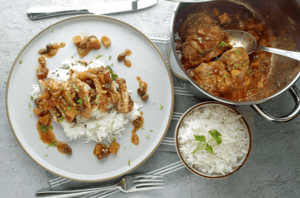
Delicious as they are, meals at restaurants and cafes tend to have a little more salt than what we’d add to our home cooking. Most of the time, we can’t to see how much salt is being added to our meals, which makes it much more difficult to control how much we consume.
With restaurants and cafes closed, we’re forced to spend more time in our kitchens, perfecting our culinary skills and embracing our inner chef - which isn’t such a bad thing!
Cooking at home not only allows us the opportunity to experiment with new flavours and different cooking techniques, it also enables us to be aware of how much salt we add to our food when cooking, as well as the salt we add at the dinner table.
In recognition of Salt Awareness Week, and as an ode to the up-and-coming stay-at-home chefs, this blog post shares exante’s guide to adding flavour to your meals, without going overboard on the salt.
Salt and your health
For adults, it’s recommended to eat no more than 6g of salt per day. That’s equal to around 1 teaspoon. Public Health England suggests the average adults is consuming much higher! [2]
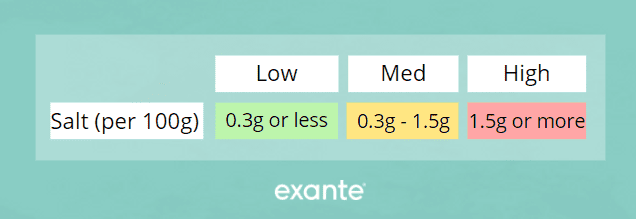
Having too much salt can cause raised blood pressure and may increase your risk of heart disease and stroke [1].
Reducing the amount of salt in our diet can have lots of beneficial impacts on our health, including reducing our risk of developing heart disease, stroke and other long term health conditions.
Ever wondered why your face looks a little puffy the morning after a takeaway? Excessive amounts of salt in our diet can also increase the amount of water our bodies retain, leading to puffiness, bloating and water weight [3].
Reading the label
Some manufacturers choose to include ‘traffic light’ labels on their packaging. This is a simple way of showing the volume of each ingredient per portion. The colours indicate whether the amount of each nutrient is high, medium, or low. See the example below.
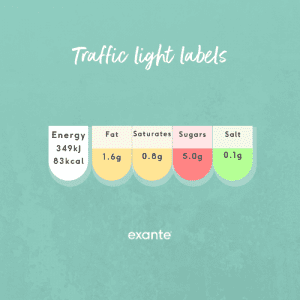
Alternatively, on the back of the package, you’ll find a full breakdown of energy and nutrients per 100g and sometimes per portion. It’ll look more like this:
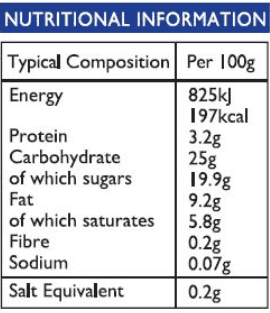
How can exante help?
Every single one of our exante products abides by strict EU regulations and all the nutrients are clearly stated on the nutrition label on the back of each packet and on our website. Since our exante products are pre-portioned or scoops with portion guides, you can don’t have to worry about doing any extra calculations. You can simply look at the ‘per portion’ sections of each product you consume, then add those up.
To make sure you’re having less that 6g of a day, here’s how exante can fit into your routine:
Breakfast: Raspberry Brownie Shake (0.72g)
Lunch: Vanilla Shake (0.93g)
Dinner: Chocolate Coconut Meal Bar (0.89g)
Snack: Mango Smoothie Shake (0.7g)
Breakfast: Vegan Coffee Walnut Shake (0.57g)
Lunch: exante Pizza Mix topped with ricotta, spinach and caramelised red onions (1.5g)
Dinner: Veggie Frittata. Click below for the recipe! (0.6g)
Snack: Birthday Cake Bar (0.5g)
More flavour, less salt
So, how can we bring out those rich, umami flavours, without adding extra salt? Here’s a quick run-down of just a few simple salt hacks we love:
- Add salt after tasting – Yes, that’s right. This hack goes against everything you learnt from your mother’s hand-me-down recipes. But, when we add salt too early, the flavours tend to get lost in the cooking process. Don’t add salt until you’ve tasted it, then decide for yourself if adding salt is necessary. [link to recipes]
- Use a salt alternative - Ingredients like seaweed flakes can be a tasty and healthy alternative to table salt. These can be found anywhere from large supermarkets, to independent health stores.
- Explore different flavours – Experimenting with other ingredients which have stronger flavours, such as lemon, vinegar, garlic, pepper and spices, can help reduce the need to add extra salt to meals. Our in-house food scientist recommends using garlic and onions as a base for most dishes to enhance all the natural flavours!
- Eat less prepared foods – Though we love the convenience of grab-and-go, pop-it-in-the-mic-and-it's-done sort of foods. Oftentimes this is where salt can pile up the most. With its subtle presence in our favourite ready meals or sweet cakey treats, it’s easy to overlook the amounts of salt inside.
- Keep an eye on the label – Now you know how to check the label to see what is classed as low, medium, or high salt. Sometimes, salt can creep into our diets where we least expect it. It’s always worth checking the label.
- Choose the low-salt option - These days it’s easy to find low-salt options, from condiments to ready meals. Opting for these versions can help us reduce the amount of salt we consume in our diet.
So, that covers just a few simple ways we can manage our salt. Make sure you follow our Instagram and keep an eye out this week for some mouth-watering recipes that’ll have you leaping for the kitchen – and guess what... They’re low salt!


